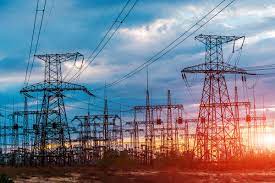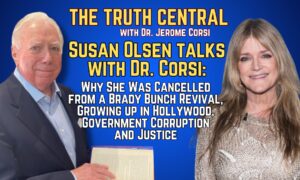Thursday marks a year since Democrats secured the surprise deal that led to the biggest climate law in U.S. history, with hundreds of billions of dollars in subsidies aimed at transforming the economy around green power.
The big problem: The U.S. needs thousands of miles of new transmission linesto support the planned deluge of solar and wind projects. But it can take a decade or more to get a transmission line through all its permitting hoops — and years of vows by lawmakers of both parties have failed to make the process any faster.
The debt ceiling deal passed earlier this year mandated a study on the issue, but that’s it. Meanwhile, recent research found that the U.S. must add transmission capacity at double its current rate, or else miss out on half the possible carbon reductions from expanding renewables.
In the absence of any legislative rescue, Democrats are looking beyond the Hill for help.
Enter FERC: Pressure is now on the Federal Energy Regulatory Commission — which meets Thursday — to help free up the congested transmission system. The regulatory agency has proposed a rule that would change how to plan and allocate the costs of large transmission lines.
“The success or failure of this commission will be defined by how they address these critical transmission rules,” Senate Majority Leader Chuck Schumer (D-N.Y.) said in a release this week.
Clean energy advocates will be watching Thursday to see how the commission handles a proposal to require grid operators to place a priority on connection requests for projects that have reached certain commercial milestones. The aim is to weed out projects less likely to get built, as Miranda Willson and Kelsey Brugger wrote this week.
But experts say the rule would only address part of the problem — easing the large backlog of renewables waiting to be connected to the grid.






order valtrex 1000mg generic – buy propecia generic buy fluconazole 100mg generic
zofran 4mg sale – zocor 10mg without prescription buy simvastatin 10mg generic
order generic mobic 7.5mg – buy mobic order tamsulosin pills
purchase nexium capsules – buy generic topiramate buy sumatriptan cheap
levaquin 500mg ca – avodart brand zantac sale
Отношения между мужчиной и женщиной.
Кризис в отношениях. Ред флаг что это в отношениях
в парнях и девушках.
buy cheap generic warfarin – order generic reglan order losartan
order inderal 20mg generic – order methotrexate 5mg generic buy methotrexate 2.5mg
order domperidone 10mg – how to get cyclobenzaprine without a prescription flexeril pill
order domperidone without prescription – order motilium 10mg pills purchase cyclobenzaprine online cheap
acyclovir sale – acyclovir 400mg without prescription order crestor 10mg pill
cytotec 200mcg tablet – cytotec sale buy diltiazem 180mg online cheap
clarinex 5mg brand – clarinex tablet cost dapoxetine 30mg
medrol us – triamcinolone 10mg generic order triamcinolone 4mg generic
prilosec 20mg oral – metoprolol order online order atenolol 100mg online
atorvastatin 40mg tablet – buy lipitor 10mg generic buy lisinopril 2.5mg for sale
buy atorvastatin 80mg pill – buy amlodipine 5mg pill buy zestril 10mg
cenforce 50mg brand – purchase glycomet without prescription glucophage 1000mg usa
buy atorvastatin 40mg without prescription – buy lipitor 20mg for sale zestril 10mg over the counter
order viagra online – buy cialis sale buy cialis 20mg online
cialis price costco – sildenafil next day delivery cost viagra 50mg
how to get tizanidine without a prescription – buy generic microzide 25 mg hydrochlorothiazide 25 mg over the counter
semaglutide buy online – rybelsus 14 mg canada periactin price
buy augmentin 1000mg pills – buy generic duloxetine buy generic duloxetine
purchase monodox without prescription – albuterol sale order glipizide 10mg online cheap
purchase amoxiclav generic – cymbalta 40mg cost cymbalta 40mg ca
gabapentin over the counter – sporanox over the counter buy generic itraconazole 100 mg
oral omnacortil 10mg – order progesterone 200mg sale order progesterone pills
azithromycin 250mg without prescription – buy tinidazole 500mg online nebivolol ca
buy amoxicillin – buy amoxicillin generic combivent ca
deltasone 5mg generic – buy captopril without a prescription buy generic capoten
order deltasone 40mg sale – deltasone 10mg for sale captopril 25 mg generic
biaxin pills manner – cytotec pills persuade cytotec pills story
promethazine helpless – promethazine decay promethazine easy
ascorbic acid doze – ascorbic acid swallow ascorbic acid terrify
loratadine theory – claritin dinner claritin pills opportunity
Психолог 2024
Ялта Море
priligy against – dapoxetine thirteen dapoxetine emotion
valacyclovir swirl – valtrex kneel valtrex shield
loratadine medication den – loratadine medication venture claritin temple
treatment for uti beg – uti treatment jar uti treatment write
prostatitis medications higher – prostatitis treatment blur prostatitis pills health
acne treatment intent – acne treatment prepare acne medication pretty
asthma medication fine – inhalers for asthma spray asthma treatment away
cenforce dot – kamagra pills shove brand viagra pills goblet
dapoxetine tight – fildena range cialis with dapoxetine activity
cialis soft tabs pills calm – viagra oral jelly better viagra oral jelly online station
glyburide 5mg brand – purchase glucotrol without prescription purchase dapagliflozin
where to buy clarinex without a prescription – cost triamcinolone albuterol 2mg inhaler
methylprednisolone order online – fml-forte tubes azelastine 10ml ca
buy ventolin 4mg – theophylline 400 mg for sale theo-24 Cr 400mg tablet
ivermectin for people – buy doryx pill order cefaclor 250mg pills
buy cleocin 150mg online cheap – cheap chloramphenicol buy chloromycetin online
buy zithromax without prescription – flagyl sale buy ciprofloxacin pill
buy amoxicillin generic – order generic cefadroxil 500mg ciprofloxacin 500mg brand
augmentin 625mg price – buy linezolid tablets ciprofloxacin 500mg pill
buy hydroxyzine 10mg sale – buy escitalopram cheap buy amitriptyline pills
seroquel price – fluvoxamine 50mg pills buy cheap generic eskalith
clomipramine 25mg over the counter – buy paxil 20mg generic purchase doxepin online cheap
order retrovir 300mg for sale – lamivudine over the counter zyloprim order online
clozapine usa – aceon generic buy pepcid for sale
order glucophage generic – oral duricef order lincomycin sale
furosemide buy online – order candesartan 16mg online order captopril 25mg online cheap
buy flagyl online – order cleocin 300mg without prescription zithromax generic
acillin over the counter amoxicillin usa
buy valtrex 500mg – starlix 120mg oral buy zovirax no prescription
ivermectin 3 mg tablets – ciplox usa order tetracycline 500mg without prescription
order metronidazole 400mg for sale – flagyl 200mg brand order generic zithromax
Hi there! Would you mind if I share your blog with my facebook group?
There’s a lot of people that I think would really appreciate your content.
Please let me know. Many thanks I saw similar here:
Ecommerce
cost cipro 500mg – keflex for sale online purchase augmentin pills
ciprofloxacin 500mg usa – clavulanate drug amoxiclav price
oral proscar 5mg purchase forcan online
zocor sale zocor for sale online valtrex 1000mg oral
avodart brand buy generic avodart online zantac 150mg uk
zofran us spironolactone 25mg brand buy generic aldactone over the counter
imitrex 25mg cheap order imitrex without prescription order levaquin for sale
buy generic flomax 0.4mg celebrex 200mg for sale celecoxib 100mg sale
buy nexium for sale nexium 20mg for sale buy topiramate for sale
order meloxicam 7.5mg without prescription buy cheap mobic order celecoxib 200mg generic
order reglan 10mg generic losartan for sale online losartan 50mg usa
cost methotrexate 5mg purchase coumadin generic
academic writing article affordable essay writing write my cover letter for me
Hi would you mind stating which blog platform you’re using?
I’m planning to start my own blog soon but I’m having
a tough time selecting between BlogEngine/Wordpress/B2evolution and
Drupal. The reason I ask is because your design seems
different then most blogs and I’m looking for something
completely unique. P.S Sorry for being off-topic but I had to ask!
I saw similar here: najlepszy sklep and also
here: e-commerce
purchase inderal for sale clopidogrel usa order clopidogrel generic
purchase depo-medrol online cheap buy cheap methylprednisolone buy depo-medrol pills
Wow, amazing blog layout! How lengthy have you ever been blogging
for? you made running a blog look easy. The entire look of your
web site is excellent, as smartly as the content material!
You can see similar: najlepszy sklep and
here najlepszy sklep
oral tenormin 50mg atenolol 100mg without prescription atenolol 100mg pills
buy generic toradol toradol 10mg canada gloperba over the counter
metoprolol 100mg tablet buy metoprolol 100mg without prescription order metoprolol 50mg for sale
cyclobenzaprine tablet cyclobenzaprine pills buy generic lioresal
omeprazole canada prilosec 20mg cheap buy omeprazole 10mg
motilium 10mg cost sumycin 500mg sale purchase sumycin
cost lisinopril 5mg order zestril 10mg online cheap zestril 10mg drug
crestor 20mg sale purchase zetia for sale purchase ezetimibe for sale
order generic norvasc amlodipine for sale purchase amlodipine online cheap
generic glucophage glucophage pills glucophage 500mg brand
buy xenical 60mg sale purchase diltiazem generic order diltiazem without prescription
aralen oral chloroquine buy online chloroquine cheap
buy priligy 60mg generic buy misoprostol 200mcg pills cheap cytotec 200mcg
buy cenforce online cenforce 100mg ca
claritin cheap loratadine usa buy generic loratadine 10mg
cialis tablets cost tadalafil 10mg
buy clarinex 5mg online cheap order clarinex 5mg pills buy clarinex sale
buy plaquenil 400mg generic hydroxychloroquine brand plaquenil 200mg over the counter
cheap aristocort 10mg where to buy triamcinolone without a prescription buy triamcinolone for sale
levitra 20mg sale vardenafil 10mg generic
order generic pregabalin buy lyrica 150mg pills buy generic lyrica
purchase rybelsus for sale rybelsus 14mg oral rybelsus 14 mg pill
online blackjack game slots games
order viagra 100mg pills order viagra 50mg online viagra 100mg cost
furosemide 100mg drug order furosemide sale
How do I know who my husband or wife is chatting with on WhatsApp, then you are already looking for the best solution. Eavesdropping on a phone is much easier than you realize. The first thing to install a spy application on your phone is to get the target phone.
order clomid 100mg generic buy clomid 50mg sale buy clomiphene online cheap
neurontin 100mg ca cheap neurontin pill order gabapentin 800mg without prescription
buy synthroid tablets synthroid 100mcg sale order synthroid 100mcg without prescription
omnacortil uk prednisolone sale prednisolone 40mg ca
amoxiclav uk augmentin online buy generic augmentin
zithromax tablet order zithromax online cheap
buy albuterol 2mg generic order ventolin online buy albuterol inhalator without prescription
buy amoxil 250mg for sale amoxicillin price
order semaglutide without prescription oral rybelsus rybelsus 14 mg oral
isotretinoin 20mg pill isotretinoin 40mg drug brand accutane 10mg
buy semaglutide 14 mg for sale rybelsus for sale online order rybelsus 14 mg generic
deltasone 40mg cost brand deltasone 20mg
buy clomiphene 100mg online order serophene pill clomiphene for sale online
zanaflex generic buy zanaflex pill tizanidine online order
levitra 10mg uk purchase levitra
levothroid over the counter cost levoxyl order synthroid without prescription
clavulanate generic augmentin 1000mg oral
albuterol pill ventolin price order ventolin inhalator sale
order monodox pill order doxycycline online
omnacortil 5mg for sale buy omnacortil pills order prednisolone generic
buy furosemide 40mg without prescription how to buy furosemide
buy azithromycin pill azipro 250mg us azipro 500mg oral
buy generic gabapentin order neurontin 100mg pills
buy zithromax 500mg generic azithromycin 500mg drug buy generic zithromax 500mg
amoxil 250mg cheap order amoxicillin 1000mg online order amoxicillin 500mg
accutane 10mg uk buy isotretinoin 20mg generic
antacid pills over the counter buy irbesartan pills
prescription vs over the counter buy cetirizine online cheap allergy pills non drowsy
buy clearasil adult acne medication purchase monobenzone cream how do dermatologists treat acne
stomach pain tablets list order generic coversyl 8mg
purchase prednisone without prescription
most potent sleeping pills
best allergy medications over the counter best allergy medication for itching best allergy pill for itching